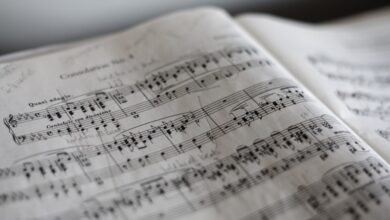Reviving Forgotten Instruments: Resurrecting Lost Sounds

Are you tired of the same old tunes? Looking for a musical experience that transports you to a bygone era? Then, prepare to be amazed as we delve into the captivating world of reviving forgotten instruments and resurrecting lost sounds.
In today’s fast-paced digital age, where modern technology dominates the music industry, it’s easy to overlook the rich heritage of traditional instruments that have been relegated to the shadows. However, a growing movement is dedicated to breathing new life into these forgotten gems, bringing their unique timbres and melodies back into the spotlight.
Imagine the warm, mellow tones of a baroque lute filling the air, or the haunting melodies produced by an ancient serpent. These instruments hold stories of their own, connecting us with our ancestors and their cultural expressions. By reviving these forgotten instruments, we not only preserve our musical history but also unlock a treasure trove of sonic possibilities.
So, how does one go about resurrecting lost sounds? It starts with dedicated artisans and musicians who meticulously study historical records and instrument fragments. These experts painstakingly recreate the instruments using traditional techniques and materials, ensuring an authentic replication of the original design. The result is awe-inspiring—a tangible link between past and present, ready to produce enchanting melodies once more.
Revival projects often begin with the search for surviving artifacts, examining intricate details and deciphering ancient manuscripts. This detective work helps uncover the secrets of long-lost instruments, providing valuable insights into their construction, playing techniques, and repertoire. With this knowledge, skilled craftsmen can construct faithful replicas that capture the essence of the original instrument.
The resurrection of forgotten instruments not only serves as a testament to human ingenuity but also inspires contemporary musicians to explore uncharted territories of sound. These instruments offer a distinct sonic palette, adding depth and diversity to modern compositions and performances. They challenge conventional boundaries and invite musicians to embrace the unfamiliar, fostering creativity and innovation.
Reviving forgotten instruments is a captivating journey that allows us to rediscover the beauty of lost sounds. By honoring our musical heritage and embracing the uniqueness of these instruments, we open doors to new artistic expressions that bridge the gap between past and present. So, let us embark on this remarkable voyage together, as we celebrate the resurrection of lost melodies and enchanting timbres that have long been silenced but are now ready to be heard once more.
Musical Archaeologists Unearth Forgotten Instruments, Bringing Lost Sounds to Life
Introduction:
Have you ever wondered what ancient music sounded like? Thanks to the incredible work of musical archaeologists, we can now experience the enchanting melodies and rhythms of forgotten instruments from centuries past. These dedicated researchers delve into the depths of history, unearthing ancient musical artifacts and reviving the sounds that once graced our ancestors’ ears. Let’s embark on a captivating journey as we explore how musical archaeologists are resurrecting long-lost melodies and unlocking a treasure trove of sonic wonders.
Unveiling the Past:
Imagine holding in your hands an instrument that has been silent for thousands of years—an artifact steeped in history and mystery. Musical archaeologists painstakingly excavate archaeological sites, peeling back layers of time to discover hidden treasures. In their expeditions, they unearth ancient flutes, lyres, drums, and other forgotten instruments that have been buried beneath the sands of time. These relics provide invaluable insights into the musical traditions of ancient civilizations.

Breathing Life into Ancient Melodies:
Once these precious artifacts are uncovered, the real magic begins. Skilled musicians collaborate with musical archaeologists to meticulously study and recreate the playing techniques, tuning systems, and musical scales used by our ancestors. By analyzing the physical characteristics of the instruments and studying depictions in ancient artwork, they piece together a musical puzzle that has remained unsolved for centuries.
Discovering Lost Sounds:
The process of reconstructing and playing these ancient instruments is akin to resurrecting the past. As skilled hands pluck strings or skillfully blow air through the hollow tubes, forgotten melodies resurface, filling the air with celestial harmonies. The rich timbre of an ancient lyre or the haunting echoes of a forgotten flute transport us to a time long gone, allowing us to immerse ourselves in the cultural tapestry of our ancestors.
Preserving Cultural Heritage:
The work of musical archaeologists extends beyond mere academic curiosity. By reviving these forgotten sounds, they honor and preserve the cultural heritage of diverse civilizations. Every note played on an ancient instrument is a testament to the ingenuity and creativity of past societies. It reminds us that music has always been a universal language, capable of transcending time and connecting us to our shared human history.
Conclusion:
Thanks to the dedicated efforts of musical archaeologists, the melodies of antiquity have found their voice once again. Through their meticulous research and skilled performances, these remarkable individuals bring to life the forgotten instruments of our ancestors. As we listen to these resurrected sounds, we are reminded of the timeless power of music to bridge the gap between past and present, expanding our understanding and appreciation of the rich tapestry of human culture.
Reviving the Ghosts of Melody: Rediscovering Ancient Instruments and Their Enchanting Tunes
Are you ready to embark on a musical journey that transcends time? Prepare to be captivated as we delve into the realm of ancient instruments and their mesmerizing melodies. In this article, we will explore the enchanting tunes that echo through history, reviving the ghosts of melody.
Have you ever wondered what it would be like to hear the haunting sound of an ancient lyre or the ethereal notes of a medieval hurdy-gurdy? These long-forgotten instruments hold the secrets of bygone eras, waiting to be rediscovered. Their unique timbres and resonances can transport us to distant lands and evoke emotions long buried in the depths of our souls.


Imagine the delicate plucking of strings on a harp-like kithara, echoing through marble halls. Picture the rhythmic beats of a bodhrán, a traditional Irish frame drum, igniting a lively Celtic dance. These ancient instruments were not merely tools of music-making; they were vessels of culture and tradition, telling stories of love, war, and the human experience.
The revival of ancient instruments is not just a nostalgic pursuit; it is a testament to the enduring power of music. It allows us to reconnect with the past, bridging the gap between generations and preserving our cultural heritage. When we embrace these forgotten sounds, we infuse new life into them, breathing fresh melodies into ancient bones.
But where can we find these relics of musical history? Museums and private collectors house some of these treasures, lovingly preserving them for future generations. Skilled craftsmen and musicians dedicated to reviving ancient music meticulously recreate these instruments, using both historical records and archeological findings as their guides.
As we embark on this journey to rediscover ancient instruments, let us be reminded that music has no boundaries. Regardless of time or place, the power of melody unites us all. So, let us embrace the ghosts of melody and unlock the timeless enchantment that lies within these ancient instruments. Get ready to be transported, for the symphony of the past awaits your ears, eager to weave its magic once more.
From Dust to Symphony: Innovative Efforts Bring Back Forgotten Instruments from Oblivion
Introduction:
Have you ever wondered about the forgotten instruments that lie hidden in the depths of history? Those enchanting melodies that once filled the air, now reduced to mere relics collecting dust. But fear not, for a new wave of innovation is sweeping through the music world, resurrecting these long-lost treasures and breathing life into their forgotten tunes. In this article, we will explore the remarkable efforts undertaken by passionate individuals and organizations to revive these instruments, transcending time and bringing back the magic of the past.
Reviving Lost Melodies:
Imagine stepping back in time, surrounded by the lush sounds of centuries-old instruments. Thanks to dedicated craftsmen and musicians, this dream is becoming a reality. These unsung heroes scour museums, libraries, and archives, meticulously studying ancient manuscripts and blueprints to recreate instruments that have been lost to the ages. By combining their expertise with modern technology, they ensure each recreated instrument faithfully captures its original essence.
Preserving Cultural Heritage:
The revival of forgotten instruments goes beyond just musical appreciation; it is an endeavor to safeguard our cultural heritage. These instruments are windows into the traditions and stories of our ancestors. Through their resurrection, we gain a deeper understanding of the music that shaped different eras and cultures. Each restored instrument brings with it a piece of history, connecting us to the past and enriching our present.
Unleashing Musical Diversity:
In the symphony of contemporary music, diversity takes center stage. The reintroduction of forgotten instruments adds unique timbres and textures to the rich tapestry of musical expression. Like rare gems discovered anew, these instruments offer fresh possibilities and inspire composers and performers to explore uncharted territories. By embracing the old alongside the new, musicians can create harmonies that transcend time, evoking emotions that resonate across generations.
Igniting Curiosity and Wonder:
Just as a hidden treasure sparks curiosity, the revival of forgotten instruments captivates both musicians and audiences alike. It is an invitation to rediscover lost sounds and embark on sonic adventures. The melodic whispers of these revived instruments invite us to explore unexplored realms, fueling our imagination and evoking a sense of wonder. In this journey from dust to symphony, we are reminded of the enduring power of music to transcend time and touch our souls.
Conclusion:
Forgotten Harmonies Resurface: Pioneering Musicians Breathe New Life into Neglected Instruments
In the ever-evolving landscape of music, where modern technology and electronic beats dominate the airwaves, it’s easy to forget the rich heritage of traditional instruments. However, a remarkable resurgence is taking place as pioneering musicians seek to revive neglected instruments, unearthing forgotten harmonies that resonate with both nostalgia and innovation.
Amidst a sea of synthesizers and digital samplers, these trailblazers are embracing instruments that have long been overshadowed. From the enchanting tones of the theremin to the soulful melodies of the hurdy-gurdy, these once-forgotten instruments are experiencing a renaissance in the hands of visionary artists.

What makes this revival even more extraordinary is how these musicians are infusing their own contemporary styles and techniques into the mix. They are not simply replicating the past; instead, they are breathing new life into these neglected instruments, creating a fusion of old and new that captivates listeners across generations.
Imagine a hauntingly beautiful melody played on a glass armonica, its ethereal sound enveloping the room and transporting you to another realm. Or picture the vibrant rhythms produced by the hammered dulcimer, its strings resonating with each precise strike, igniting a fire within your soul.
This movement goes beyond mere nostalgia; it’s a testament to the power of human creativity and the resilience of musical expression. By rediscovering neglected instruments, these musicians are challenging our preconceived notions of what music should be, pushing boundaries and expanding the sonic palette available to us.

The impact of this resurgence extends beyond the music itself. It serves as a reminder of the importance of preserving cultural heritage and embracing diversity in art. Just as languages evolve and adapt over time, so too does music, and by reviving these forgotten harmonies, we honor our collective history while paving the way for new artistic discoveries.




